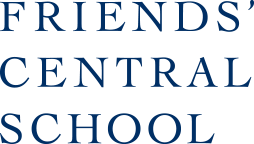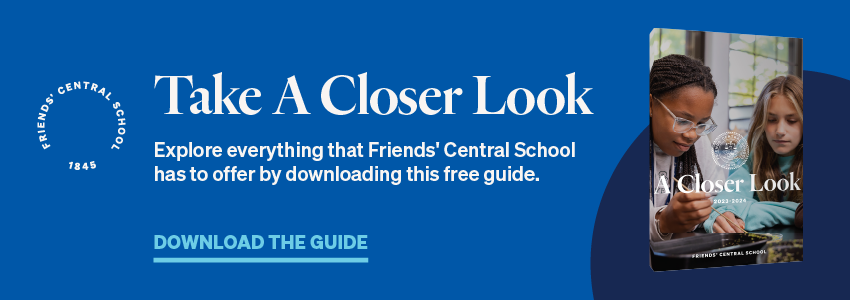.jpg?width=848&name=Life-after-covid-tips-to-reacclimate-(insert).jpg)
As we leave the previous school year behind, it’s clear that children and caregivers alike have weathered the most unusual year in recent memory. Most students have spent the past year experiencing some measure of distance learning—whether fully remote or as part of a hybrid model.
For older students, the year ahead, and the promise of a return to some level of pre-pandemic normalcy, is exciting. After all, they can remember what school was like before “distance learning” was a part of their vocabulary. But for younger students, the transition to fully in-person learning may be more difficult.
Free Downloadable Guide: Take a Closer Look at Friends' Central School
Whatever the situation or sentiment, for parents and caregivers, preparing students for the year ahead and the return to in-person learning will be an important step in ensuring young learners begin the school year on strong footing.
Transitioning Back to In-Person Learning
The COVID-19 pandemic presented unique challenges to the world of education. For children across the country, the school year looked totally different than ever before and for nearly every student, distance learning became a reality.
Some schools, like Friends’ Central School, were able to continue offering in-person learning for most of the school year, thanks to the collective efforts of students, faculty, families, and administrators. However, students who did experience in-person learning had to adjust to a different school environment as well; one where social distancing and masking were the daily reality, and the traditional atmosphere of togetherness and openness were often set aside in the name of safety.
Whatever model students experienced in the past year, the upcoming school year will truly be a “new normal.” And whether students are continuing on with in-person learning, returning to in-person learning from a year of distance learning, or beginning in-person learning for the first time ever, caregivers and educators alike will need to aid in the transition and teach children how to “do school now.”
Back to School Checklist
1. Establish a routine.
Parents and caregivers will find that establishing a routine can be crucial in successfully transitioning or re-introducing young learners to an in-person model of learning. Discussing with children what changes they can expect to see as they enter the school year will help manage expectations and provide a smoother re-entry.
This can be as simple as discussing the changes they will face as they re-enter school, and beginning to mimic the schedule for a typical in-person school day during the waning weeks of Summer. Getting children into the habit of waking up earlier, eating breakfast at a set time and getting themselves ready for the day – getting dressed, packing their backpack and completing assignments the night before – can help young learners feel informed and in control as they enter the school year.
2. Communicate with your child.
As with all childhood transitions, communication will aid in a successful shift to in-person learning. Talking to your child as they prepare to go back to school and asking what they are most excited for and what concerns they may have will help caregivers appropriately prepare for any challenges ahead, and can present opportunities to maximize areas of positivity and excitement.
Likewise, parents and caregivers should plan to continuously check-in with their children, especially in the first months of in-person learning, to identify and tackle any stressors or challenges that arise and continue to celebrate the “wins” of the school day. Continuing to communicate with children allows them to feel supported and can help them successfully manage the stressors and changes ahead.
3. Prepare together.
Allowing young learners to be involved in the back-to-school process is a simple but impactful way for parents and caregivers to ensure a successful transition to in-person learning. Discussing next steps and preparing for the new school year together allows children to feel that they are part of the process and helps ensure they are mentally on board with the changes ahead.
Rowena Castillo Lesher, Assistant Principal of Friends’ Central Lower School, suggests the simple act of allowing children to review the back-to-school supply list and pick their own materials as part of the preparation process. From “selecting a new backpack to grocery shopping for snack and lunch items, including them in the preparation for school can be very helpful and empowering.”
4. Get involved.
As families prepare for the new school year, parents and caregivers should familiarize themselves with their child’s school environment and culture. Getting involved in their school’s volunteer parent/guardian organizations can help parents and caregivers stay informed and engaged so that they can provide their students with the support and information they need to succeed.
At Friends’ Central School, initiatives like PEAC (Parent Equity and Action Committee) and the Lower School Fall Project provide parents and caregivers with opportunities to get involved and contribute to the success and development of their young learners.
5. Use your resources.
Utilizing the resources available to you as a parent or caregiver is essential in successfully navigating the school year. For the upcoming year and the return to this “new normal” learning environment, these resources are especially important. Your child’s educators are the first line of information and defense in keeping your young learner happy and healthy, and they will have valuable insights into your child’s strengths and any areas they may need additional support.
Reaching out to your school’s Health Services, Counseling, and Learning Support services, teachers and administrators can help you support your student in a personalized and thoughtful way. Teachers and program directors can do everything from providing a sample schedule of the school day, to providing resources and activities tailored to your child’s strengths and weaknesses, to help set expectations for the upcoming year and ensure your child – and you – feel supported during the transition to in-person learning.
Approaching the Challenge Together
While the past year has been one of much uncertainty and upheaval, one thing parents and caregivers can be sure of as they approach the new school year is the need for families and their students to work together to navigate the new in-person learning environment.
Though the months ahead can seem both exciting and intimidating, parents and caregivers who approach the new school year with communication, collaboration, and a simple checklist should find that their young learners are ready and willing to tackle the new school year and in-person learning.



